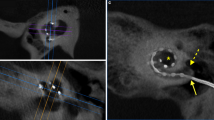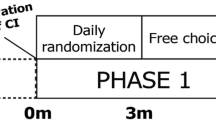Abstract
Purpose
The use of image processing techniques to estimate the position of intra-cochlear electrodes has enabled the creation of personalized maps to meet the individual stimulation needs of cochlear implant (CI) recipients. The aim of this study was to evaluate a novel technique of electrode deactivation based on postoperative cone beam computed tomography (CBCT) images in post-lingually deafened adult CI recipients.
Methods
Based on postoperative CBCT images, the positioning of the electrodes was estimated in relation to the modiolus in 14 ears of 13 post-lingually deafened adult CI recipients. The electrodes sub-optimally positioned or involved in kinking and tip fold-over were deactivated. Speech perception scores in silence and in noise were obtained from subjects using the standard map and were followed up 4 weeks after image-based electrode deactivation reprogramming technique (IBEDRT). The participants selected their preferred map after 4 weeks of IBEDRT use.
Results
There were statistically significant improvements in the speech recognition tests in silence and noise when comparing IBEDRT performance to the standard map. All participants elected the IBEDRT as their new preferred map.
Conclusions
IBEDRT is a promising technique for fitting CI recipients and minimizing channel interaction increased by the positioning of the electrodes sub-optimally placed, thereby improving their auditory performance. We propose a novel electrode deactivation technique based on postoperative CBCT imaging, with a limited number of deactivated electrodes and a low-dosing scanning which could be applied for clinical routine.



Similar content being viewed by others
References
Waltzman SB, Cohen NL, Roland Junior T (1999) A comparison of the growth of open-set speech perception between the nucleus 22 and nucleus 24 cochlear implant systems. Am J Otol 20:435–441
Lenarz M, Sonmez H, Joseph G, Buchner A, Lenarz T (2012) Long-term performance of cochlear implants in postlingually deafened adults. Otolaryngol Head Neck 147:112–118
Vermeire K, Nobbe A, Schleich P, Nopp P, Voormolen MH, Van de Heyning PH (2008) Neural tonotopy in cochlear implants: an evaluation in unilateral cochlear implant patients with unilateral deafness and tinnitus. Hear Res 245:98–106
Wilson BS, Dorman MF (2008) Cochlear implants: current designs and future possibilities. J Rehabil Res Dev 45(5):695–730
Noble JH, Labadie RF, Gifford RH, Dawant BM (2013) Image-guidance enables new methods for customizing cochlear implant stimulation strategies. IEEE Trans Neural Syst Rehabil Eng 21:820–829
Lassig AA, Zwolan TA, Telian SA (2005) Cochlear implant failures and revision. Otol Neurotol 26:624–634
Ishiyama A, Risi F, Boyd P (2020) Potential insertion complications with cochlear implant electrodes. Cochlear Implants Int 20:1–14
Hughes ML, Stille LJ (2010) Effect of stimulus and recording parameters on spatial spread of excitation and masking patterns obtained with the electrically evoked compound action potential in cochlear implants. Ear Hear 31:679–692
Goldwyn JH, Bierer SM, Bierer JA (2010) Modeling the electrodeneuron interface of cochlear implants: effects of neural survival, electrode placement and the partial tripolar configuration. Hear Res 268:93–104
Long CJ, Holden TA, Mcclland GH et al (2014) Examining the electro-neural interface of cochlear implant users using psychophysics, CT scans, and speech understanding. J Assoc Res Otolaryngol 15:293–304
Kalkman RK, Briare JJ, Dekker DMT, Frijns JHM (2014) Place pitch versus electrode location in a realistic computational model of the implanted human cochlea. Hear Res 315:10–24
Devries L, Scheperle R, Bierer JA (2016) Assessing the electrodeneuron interface with the electrically evoked compound action potential, electrode position, and behavioral thresholds. J Assoc Res Otolaryngol 17:237–252
Abbas PJ, Hughes ML, Brown CJ et al (2004) Channel interaction in cochlear implant users evaluated using the electrically evoked compound action potential. Audiol Neurotol 9:203–213
Hughes ML, Stille LJ (2008) Psychophysical versus physiological spatial forward masking and the relation to speech perception in cochlear implants. Ear Hear 29:435–452
Jones GL, Ho Won J, Drennan WR, Rubinstein JT (2013) Relationship between channel interaction and spectral-ripple discrimination in cochlear implant users a. J Acoust Soc Am 133:425–433
Moore BCJ, Glasberg BR (1993) Simulation of the effects of loudness recruitment and threshold elevation on the intelligibility of speech in quiet and in a background of speech. J Acoust Soc Am 94:2050–2062
Baer T, Moore BC (1994) Effects of spectral smearing on the intelligibility of sentences in the presence of interfering speech. J Acoust Soc Am 95:2277–2280
Zwolan TA, Collins LM, Wakefield GH (1997) Electrode discrimination and speech recognition in postlingually deafened adult cochlear implant subjects. J Acoust Soc Am 102:3673–3685
Debruyne JA, Francart T, Janssen MLJ, Douma K, Brokx JPL (2017) Fitting prelingual deafened adult cochlear implant users based on electrode discrimination performance. Int J Audiol 56:174–185
Saleh SM, Saeed SR, Meerton L, Moore DR, Vickers DA (2013) Clinical use of electrode differentiation to enhance programming of cochlear implants. Cochlear Implants Int 14:16–18
Vickers DA, Degun A, Canas A, Stainsby T, Vanpoucke F (2016) Deactivating cochlear implant electrodes based on pitch information for users of the ACE strategy. Adv Exp Med Biol 894:115–123
Zhou N, Pfingst BE (2012) Psychophysically based site selection coupled with dichotic stimulation improves speech recognition in noise with bilateral cochlear implants. J Acoust Soc Am 132:994–1008
Garadat SN, Zwolan TA, Pfingst BE (2013) Using temporal modulation sensitivity to select stimulation sites for processor maps in cochlear implant listeners. Audiol Neurotol 18:247–260
Bierer JA, Litvak L (2016) Cochlear implant programming may improve speech perception: current focusing and channel deactivation. Trends hear 20:1–12
Zhou N (2016) Monopolar detection thresholds predict spatial selectivity of neural excitation in cochlear implants: implications for speech recognition. PLoS ONE 11(10):1–18
Runge-Samuelson C, Firszt JB, Gaggl W, Wackym PA (2009) Electrically evoked auditory brainstem responses in adults and children: effects of lateral to medial placement of the nucleus 24 contour electrode array. Otol Neurotol 30:464–470
Noble JH, Gifford RH, Hedley-Williams AJ, Dawant BM, Labadie RF (2014) Clinical evaluation of an image-guided cochlear implant programming strategy. Audiol Neurootol 19(6):400–411
Labadie RF, Noble JH, Hedley-Williams AJ et al (2015) Results of postoperative, CT-based, electrode deactivation on hearing in prelingually deafened adult cochlear implant recipients. Otol Neurotol 37:137–145
Noble JH, Hedley-Williams AJ, Sunderhaus L et al (2016) Initial results with image-guided cochlear implant programming in children. Otol Neurotol 37:63–69
Schvartz-Leyzac KC, Zwolan TA, Pfingst BE (2017) Effects of electrode deactivation on speech recognition in multichannel cochlear implant recipients. Cochlear Implants 18(6):324–334
Massuda ET, Dermacy T, Hoen M, Danieli F, Amaral SA, Gnansia D, Hyppolito MA (2019) Method to quantitatively assess electrode migration from medical images: feasibility and application in patients with straight cochlear implant arrays. Cochlear Implants Int 20(5):237–241
Zou J, Lahelma J, Koivisto J, Dhanasingh A, Jolly C, Aarnisalo A, Wolff J, Pyykko I (2015) Imaging cochlear implantation with round window insertion in human temporal bones and cochlear morphological variation using high-resolution cone beam CT. Acta Otolaryngol 135:466–472
Marozeau J, Ardoint M, Gnansia D, Lazard D (2018) Acoustic match to electric pulse trains in single-sided deafness cochlear implant recipients. In: Proceedings of the international symposium on auditory and audiological research 6: 239-246
Brown CJ, Hughes ML, Luk B, Abbas PJ, Wolaver A, Gervais J (2000) The relationship between EAP and EABR thresholds and levels used to program the nucleus 24 speech processor: data from adults. Ear Hear 21(2):151–163
Hughes ML, Vander Werff KR, Brown CJ, Abbas PJ, Kelsay DM, Teagle HF, Lowder MW (2001) A longitudinal study of electrode impedance, the electrically evoked compound action potential, and behavioral measures in nucleus 24 cochlear implant users. Ear Hear 22(6):471–486
Zhao Y, Dawant BM, Labadie RF, Noble JH (2014) Automatic localization of cochlear implant electrodes in CT. Med Image Comput Comput Assist Interv 17:331–338
Zhao Y, Chakravorti S, Labadie RF, Dawant BM, Noble JH (2019) Automatic graph-based method for localization of cochlear implant electrode arrays in clinical CT with subvoxel accuracy. Med Image Anal 52:1–12
Dijkstra EW (1959) A note on two problems in connexion with graphs. Numer Math 1:269–271
Demarcy T, Vandersteen C, Guevara N, Raffaelli C, Gnansia D, Ayache N, Delingette H (2017) Automated analysis of human cochlea shape variability from segmented μ CT images. Comput Med Imaging Graph 59:1–12
Costa MJ, Santos SN, Lessa AH, Mezzomo CL et al (2015) Proposal for implementing the Sentence Recognition Index in individuals with hearing disorders. CoDAS 27(2):148–154
Costa MJ, Iório MCM, Albernaz PLM (2000) Desenvolvimento de um teste para avaliar a habilidade de reconhecer a fala no silêncio e no ruído. Pró-fono 12(2):9–16
Santos SN, Daniel RC, Costa MJ (2009) Estudo da equivalência entre as listas de sentenças em Português. Revista CEFAC 11(4):673–680
Freitas CD, Lopes LFD, Costa MJ (2005) Reliability of the recognition thresholds of the sentence in the quiet and the noise. Rev Bras Otorrinolaringol 71(5):624–630
Sipari S, Iso-Mustajärvi M, Matikka H et al (2018) Cochlear implantation with a novel long straight electrode: the insertion results evaluated by imaging and histology in human temporal bones. Otol Neurotol 39:784–793
Zuniga MG, Rivas A, Hedley-Williams A, Gifford RH, Dwyer R, Dawant BM, Sunderhaus LW, Hovis KL, Wanna GB, Noble ZH, Labadie RF (2016) Tip fold-over in cochlear implantation: case series. Otol Neurotol 38:199–2016
De Seta D, Nguyen Y, Bonnard D, Ferrary E, Godey B, Bakhos D, Mondain M, Deguine O, Sterkers O, Bernardeschi D, Mosnier I (2016) The role of electrode placement in bilateral simultaneously cochlear—implanted adult patients. Otolaryngol Head Neck Surg 155(3):485–493
Gifford RH, Hedley-Williams A, Spahr AJ (2014) Clinical assessment of spectral modulation detection for cochlear implant recipients: a non-language based measure of performance outcomes. Int J Audiol 53:159–164
Acknowledgements
The authors would like to thank Dr Michel Hoen for helpful comments on an earlier version of the manuscript
Author information
Authors and Affiliations
Contributions
All authors contributed to the study. FD designed and performed the study. TD reviewed the data and performed the analysis of the manuscript. MSAA helped in the data collection and reviewed the manuscript. ACMBR wrote parts of the manuscript. DG reviewed the data and supported the design of the study. MAH designed and wrote parts of the manuscript. All authors reviewed and approved the manuscript.
Corresponding author
Ethics declarations
Conflict of interest
The authors declare that they have no conflicts of interest.
Additional information
Publisher's Note
Springer Nature remains neutral with regard to jurisdictional claims in published maps and institutional affiliations.
Rights and permissions
About this article
Cite this article
Danieli, F., Dermacy, T., do Amaral, M.S.A. et al. Auditory performance of post-lingually deafened adult cochlear implant recipients using electrode deactivation based on postoperative cone beam CT images. Eur Arch Otorhinolaryngol 278, 977–986 (2021). https://doi.org/10.1007/s00405-020-06156-8
Received:
Accepted:
Published:
Issue Date:
DOI: https://doi.org/10.1007/s00405-020-06156-8




